How we tested the correction of bite by liners on our director
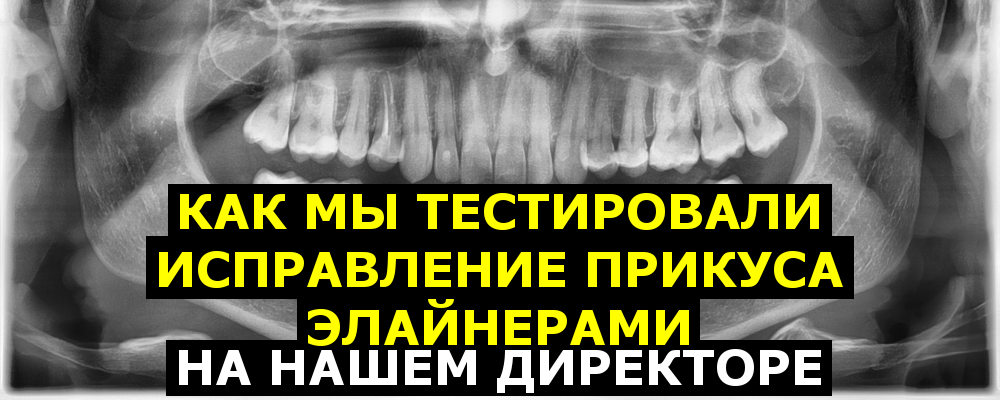
What is an aligner?
Aligners are transparent and almost invisible from the side of the mouthguards, which are put on the teeth for everyday wear and correct the incorrect position of the teeth, which was previously considered the prerogative of braces.
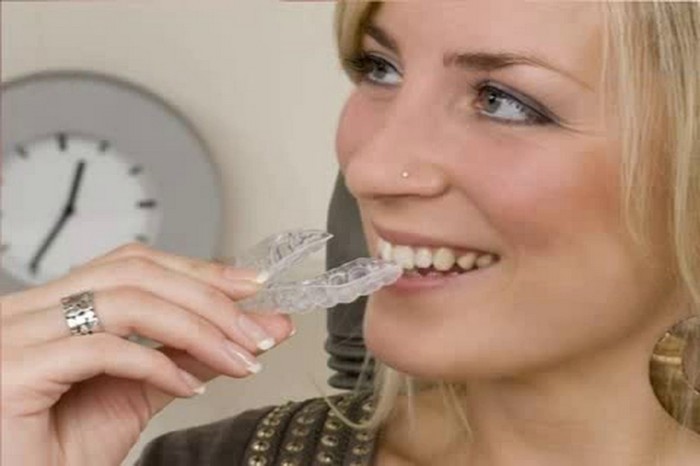
Transparent Aligner
A bit of history
The history of transparent aligners began in the distant nineties — it was then, after registering in 1997 and receiving all the necessary licenses in 1998, by 1999 Align Technology began selling its Invisalign system to American orthodontists. Already in 2000, the company launched a full-scale advertising campaign for patients, and by the end of 2001 entered the European market, releasing at least a million caps. By mid-2003, the Invisalign system was introduced as part of the course of future dentists in medical schools, and has since been distributed non-stop throughout the world.
')

Comparative pros and cons of aligners and braces
Of course, braces have their advantages. Braces are the most effective tool in the hands of an orthodontist, since his action is based on a force developed by a metal arc.
In addition, the design of the bracket system allows you to combine it with various additional elements, thereby greatly expanding the range of movement of teeth in all planes.
It is also important that the brackets are the most controlled tool in the hands of the doctor, since the specialist performs all the manipulations on his own, without leaving the patient the right to make mistakes. After all, the patient can take off controllers without control. The relative cheapness of the bracket systems is also important.
In some cases, aligners may be powerless, braces - the most potent tool.
The aligners, of course, have drawbacks, for example: narrower indications for clinical use, as compared to braces, due to the design features of cap. Aligners - a softer tool. The undoubted minus is the dependence of the result on the patient's responsible approach and the fulfillment of the doctor’s recommendations, as well as the need for additional impressions and modeling new caps, if necessary, adjusting the effect of the aligners in the process of wearing. And the higher cost, especially - if the order is ordered from abroad.
The main reason for such an explosive expansion of Invisalign is the extreme convenience of aligners compared to braces. Unlike braces, they do not injure the oral cavity with metal parts - after all, there are no such parts in them.
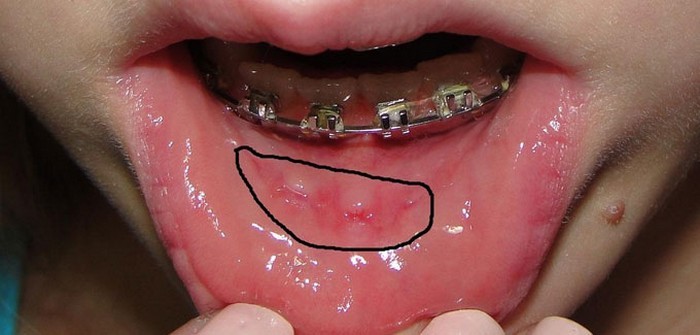
Braces injure mucous membranes
They do not spoil the tooth enamel with plates - there is no need to glue metal or ceramic plates to the teeth, there are only locks made of biocompatible plastic that affect the enamel more gently, and they need much less - not every tooth.
Brackets can seriously damage the teeth: in addition to the destructive effect of metal, there is such a harmful factor as the impossibility of normal teeth cleaning - the bracket system, unlike the aligners, the patient cannot remove himself to brush his teeth. This is fraught with carious lesions and the occurrence of inflammatory processes in the gums and mucous membranes of the oral cavity. Caries especially actively spoils tooth enamel around glued plates. After removing the bracket system, the patient risks permanently remaining a client of the dentist, but not to eliminate the initial aesthetic deficiencies.

Consequences of wearing braces
Aligners, on the other hand, do not look like a medieval instrument of torture — after all, they are almost invisible in the process of socks — it is extremely difficult to notice aligners on a person from a distance of more than a meter. This is an important fact for people sensitive to public opinion, and for everyone else - at least pleasant - in everyday life no one notices that they are worn on you. And in this they are radically different from braces, which are always noticeable.

Convenience is very important - after a while you get used to the A-liners and they are almost not felt. They are more physiological, due to the softness of their impact, and do not cause such pronounced discomfort.
Aligners can and should be taken off yourself during the meal, and sometimes just to relax from the habit - this is important in the early days of wearing. Such breaks are permissible, in total, up to four hours a day. Of course, it is advisable not to abuse it and wear them as much as possible.
By the way, about food: when wearing braces, there are significant restrictions on the diet, more precisely - the consistency of food, nothing solid can be chewed. With the use of the aligner, the patient can eat as he is used to.
Regular visits to the dentist, inevitable when wearing braces, when using the aligners occur much less frequently, every 1-2 months.
Braces are a powerful tool, but their force of impact is often excessive, and in the case of the slightest mistake of the doctor, they can damage the bone tissue of the jaws and the roots of the teeth.
In addition, the severe impact of bracket systems can cause much greater discomfort and pain.

Justin Bieber in Invisalign
It is precisely because of its convenience that transparent aligners are so popular now. You can read a lot about them on the Internet, you can see a lot of photos of satisfied users who created the smile of their dreams with their help. Among them are celebrities.
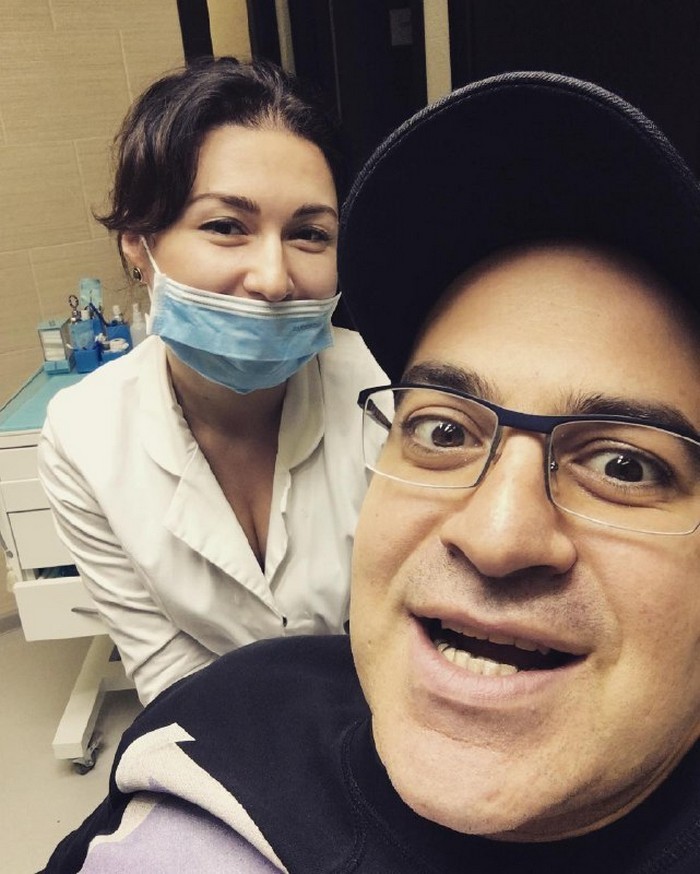
Garik Martirosyan at the reception
There are also examples of experiments on the independent production of aligners using 3D technologies.
The essence of technology
The very essence of the technology is quite simple: the dentist removes the impression from the patient's jaws, which is sent to the center for the manufacture of aligners located in the USA — either the impression itself or its three-dimensional scan. The made eyliners are sent back and placed at the disposal of the patient, usually at once with a course, and he must wear them constantly, gradually replacing one with another. The shape of the aligners is designed so that they gradually move the teeth to the correct position.

Invisaline ready for delivery to patients
So it was until recently. The production of e-liners in another country, together with international shipping, made them extremely expensive for both dentists and end-users.
Sometimes with this system there were quite expected problems.

How it happens now
Now clinics are getting smarter: they buy their own equipment, software, and do a lot of things on their own, so as not to depend on technology providers.

- The dentist removes the impression from the patient's jaw.
- Scans an image, or uses an intraoral scanner, and receives a scan directly.
- He enters the scan into the computer program and plans the treatment, coordinating it with the patient. In a special program, you can very clearly see how the teeth will gradually move and what position they will occupy as a result of the treatment.
- Creates a series of 3D models of future aligners.
- Prints these models on a 3D printer.
- According to the printouts, the aligners themselves are molded - the same caps that the patient wears.
On the pros and cons of this approach can be found here .
Yes, now there is no need to wait for a parcel from another continent, the dentist either forms the necessary aligners himself, if he has the right equipment at his disposal, or orders them in the dental laboratory nearby - now the cap can be molded using a model printed on a 3D printer and some materials Allow you to print the aligners directly.
The use of 3D technologies not only makes the process cheaper, but also makes it much faster - no more ordering abroad and waiting for delivery, if there is a need for replacement - everything is done very quickly.
Why do we experiment on a live director
Since the Top 3D Shop strives to be at the forefront of technology, and the technology of the aligners is directly related to 3D modeling and printing, we, as soon as we started working on 3D dental equipment, decided to give anybody from the staff to the dentists to feel all the nuances inside and out. create the most complete and comprehensive impression of this technology.
So there were stars that this employee turned out to be our founder and development director Vasily Kiselev. We, reluctantly, went to this sacrifice. To the glory of science!
In this picture, by the way, he is already wearing Aliners.

Such a factor as the presence of Vasily, at that time, crowded teeth of the lower jaw influenced the decision - the bite was disturbed due to abnormal growth of wisdom teeth, a classic story.

3D scans of our experimental jaws, before correction:
Upper jaw
Lower jaw

Orthopantomogram
This malocclusion did not cause trouble in everyday life, but it required some kind of solution, because it could later lead to more serious violations - such as increased abrasion of teeth.
Yes, the wrong bite can lead, and often leads not only to problems with appearance, but also to premature tooth decay, problems with digestion, and sometimes even headaches. Not to mention the increased activity of caries.
Here is the dentists constantly, it is - the consequences of running the wrong bite:
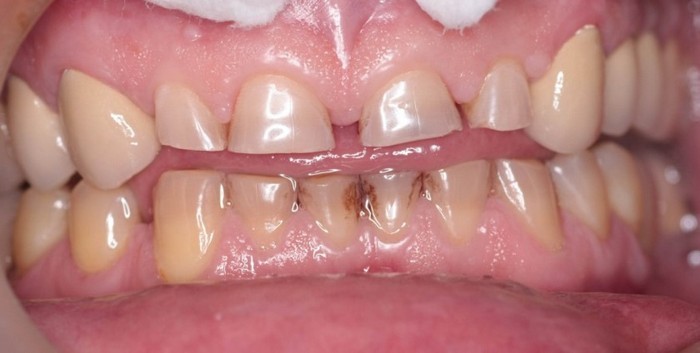
Played a role and desire to quickly test, in such a specific area, 3D-printers and materials that were already at our disposal. And also the fact that many good specialists in the field of dentistry cooperate with us, and we were able to quickly find an orthodontist who can be trusted with the treatment.
A plus was the fact that, at the beginning of the process, the wisdom teeth were already removed - this gave the doctor some freedom of maneuver. Otherwise, they most likely would have to be removed, and then wait for complete healing - the rehabilitation period can last 3-4 weeks, during which no effects on the teeth can be made.
How many eliners are worn
The course of application of the aligners, in this case, was six months - this is the minimum period for wearing such caps. This is one of their advantages - for braces, dates vary, depending on the complexity of the case, from ten months to several years.
Living example - how it happens in practice
In practice, everything happens quite simply. Vasily turned to the doctor and outlined the essence of the matter. The dentist spoke about how the treatment will take place, and took pictures from the jaws.

The next stage is the preparation of a treatment plan and coordination with the patient. This is how treatment planning happens - everything is displayed in great detail in the program. And the location of the activator locks - here they are highlighted in blue, and what the jaw will look like after adjustment.
Here you can clearly see the moment of correction of a slightly protruding upper tooth:


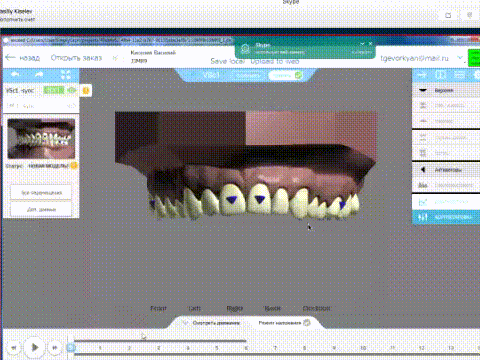
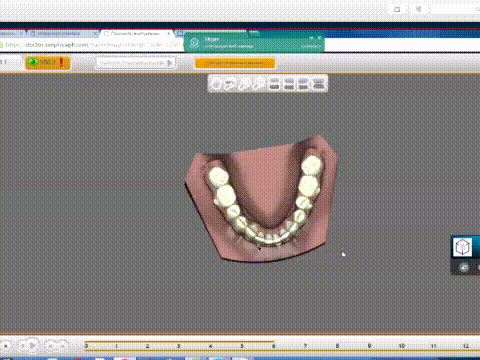
This is how the movement of the teeth is modeled:


The plan is in detail consistent with the patient, in case of need - changes.
In our case, there were changes in the planning process — the initial goal was to correct only the lower jaw, but after receiving the impressions and scans from them, it became clear that the upper teeth were also not ideal. It was decided to correct everything. The final version looked like this:




Next is the installation of locks - these are such small plastic stickers on the surface of the teeth, those very blue things in the planner, they fix the aligners and allow them to do their job properly.
Then - the creation of aligners. The formation of the aligners themselves can occur in different ways, in our case it was like this. We received from the dentist digital models of the jaws for shaping the caps - the same ones that were formed on the scans of the molds by the program, and printed them on a Formolbs Form 2 stereolithographic 3D printer made of photopolymer resin.
This is the most accurate and convenient way to create such things today.

This is how the molding process itself takes place:


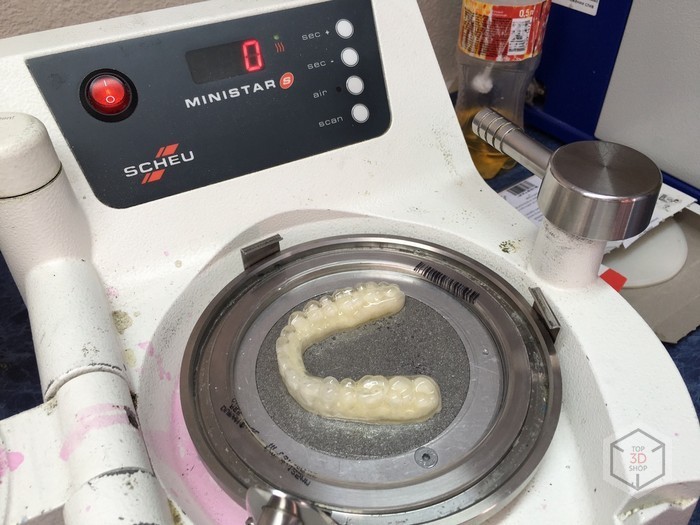
Here in this form come from the laboratory already-molded and ready-to-wear aligners.

The first pair of caps is put on and the correction process itself begins. In the first two or three days of socks, noticeable discomfort is possible, which over time causes less inconvenience. Teeth begin to move.

Sometimes, when the teeth interfere with each other, it is necessary to carry out separation - to slightly undermine them, in order to ensure the most even arrangement.
Each pair of aligners is worn for two weeks, then replaced with the next, ensuring progress in straightening.
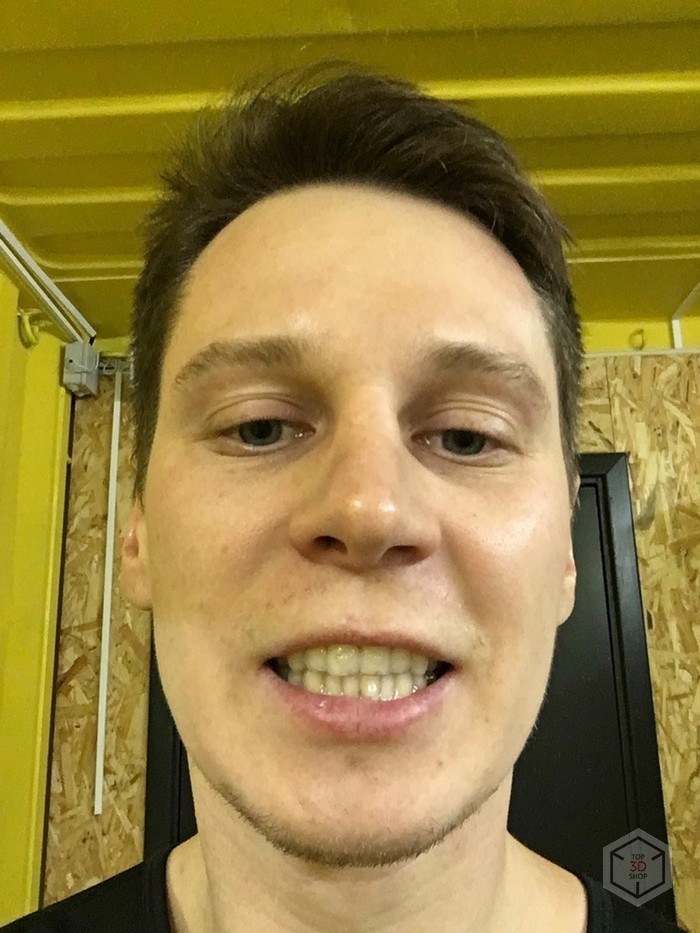
With each change of aligners, the teeth move closer to the desired result.
At the final stage, when the time of wearing the last pair of aligners ends, the locks are removed and the last examination by the doctor takes place. The teeth stood up correctly, but the smile was not perfect - Basil found a ground tooth, which needed to be restored.


Look at the result and compare with what was.

Lower jaw

Upper jaw

Smile
Subtleties, complexity, pitfalls
The important point is to straighten and move not only the crooked teeth, but also all the others. Despite the fact that patients often want to put in place only some specific teeth, because the arrangement of teeth in the jaw is interrelated - thus, correcting the bite becomes complex and this is very correct.
In addition - if the defect is only on one jaw, then the aligners will still have to be worn on both - this will create the correct distribution of stresses, which is not only important for correction, but also contributes to comfort and less discomfort.
The first step in correcting bite is the expansion of a number of teeth and the release of space for those who will move. If wisdom teeth, which had an improper growth, influenced the others, are too crowded and do not allow other teeth to move - most likely, they will have to be removed, so that there is a place for straightening. Otherwise, it would be necessary to file an enamel on all teeth, which is harmful and not very effective.
At first, no effect will be noticeable, since at first not the crooked teeth themselves are shifted, but the ones next to each other - just to give enough space for straightening. The tangible effect appears somewhere to the tenth change of cap.

An important plus of the aligners is that they can be simply removed - for the duration of the meal, or when they bring discomfort, but - no more than 4 hours a day. Apart from these breaks, they should be worn constantly.
There is a danger in this advantage - if an irresponsible patient exceeds this time limit and remains without eliners for a long time, there will not be any sense of treatment - it will pass extremely slowly, if not without progress.
You can find a lot of reviews of disgruntled consumers, who independently ruined their treatment in this way, and then pour out their regrets about the wasted money spent on the pages of sites.
Relatively inconvenient: you need to constantly carry with you a container for the aligners and a brush with toothpaste - both the aligners themselves and the teeth under them need to be cleaned after each meal, not counting the usual procedures in the morning and evening. This may seem tedious to someone, but it quickly becomes a habit and brings only benefits, even after completing the course.

Basil combined wearing a cap with the use of a remineralizing gel to strengthen the enamel, and this is an additional plus from wearing the aligners - the teeth become stronger and healthier.
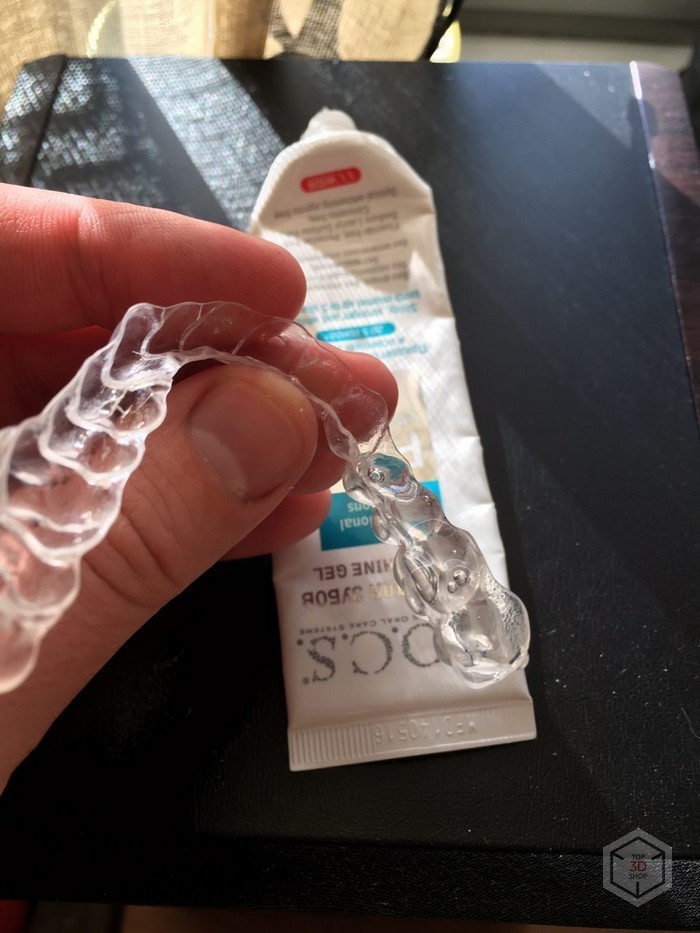
There are special tablets for the preparation of a disinfectant solution for the care of alliners.

But when there is no possibility to observe the entire ritual, they can be simply washed thoroughly with water.
Eliners can sometimes crack. Sometimes it happens. In this case, you should contact your orthodontist and fix them, or take a replacement. This is usually included in the course fee and is not charged separately.
There is an important nuance: during the process, without fail, it is necessary to revise the treatment and correct it, and if something went wrong, create new casts and new caps. This usually occurs within the framework of the amount already paid and does not require additional financial injections from the client. The problem arises from the possible difference between the actual movement of the teeth and the programmed one. If the error becomes large, then the course adjustment is necessary.
Sometimes it is found that some teeth interfere with each other to stand exactly. This does not happen so often: in our case, during the whole treatment time, we had only three times to slightly sharpen them by 100 microns.
An unexpected pleasant surprise: in the lower jaw of Basil there was a problem tooth - moreover, completely healthy, but hypersensitive to stress and temperature. The neck of the tooth became bare because of the displacement and responded with a sharp pain to cold drinks or attempts to eat something hard - an apple, for example. After the start of wearing the aligners, this tooth, along with the rest, began to move, as a result, it stood up correctly, the sensitive area was closed and stopped reacting painfully to temperature changes and pressure.

Here is this very tooth, before and after. No more hurts!
It was a very tangible and unexpected bonus, which underlines the importance of proper bite.
How much is it
The cost of the course of the aligners, with local production, is 80,000 rubles and more, depending on the complexity of the particular case.
In our case: the cost of a course of 16 steps, that is, including 16 shifts of caps, was about 140,000 rubles, taking into account the fact that we made the aligners ourselves, and the cost of a doctor’s services was 90,000 rubles.
Advantages and disadvantages
+ Aligners do not interfere with everyday life.
+ When everyday wear invisible, if you do not look carefully.
+ Do not injure the oral cavity and tooth enamel.
+ Quite quickly cease to deliver significant discomfort.
+ Ability to self-withdraw if necessary.
+ Adequate cost - the course of the aligners will cost no more than braces and related medical care, although this is not always obvious.
+ Ability to use remineralizing and bleaching gels
- The need for constant care - brushing your teeth, before putting on the aligners after each meal, washing the caps themselves.
- Sometimes they break.
- The ability to self-withdraw - yes, this is a plus and a minus. Without self-discipline, removing them too often, you just throw money away.
- The need to record the result of nightly wearing the final mouth guard for several years. But, it is recommended after applying braces, it is difficult to call this a characteristic minus of aligners.
Total
Transparent aligners have shown themselves from the best side, despite numerous negative reviews in the network - the practice shows the great potential of this technology.
Experience in creating elieners and a comprehensive study of this issue helped us create a profitable solution for dental clinics, which we have already successfully sold to orthodontists throughout the country.
In addition, we received an incentive to further explore the use of additive technologies in dentistry and other fields.
By the way! You can get acquainted with this case live, as well as learn more about the use of 3D technologies in dentistry and not only, you can at our exhibition and conference:
“Announcements and trends in the development of the Russian market for 3D printing and 3D scanning technologies” ,
which will be held on April 14 in Moscow. This year - with a dental accent.
Come April 14, at 12:00, at the address: Moscow, st. Tverskaya, d. 7, 9 entrance, 5th floor.
It will be interesting.
Want more interesting news from the world of 3D technology?
Subscribe to us in the social. networks:




Source: https://habr.com/ru/post/402305/
All Articles
